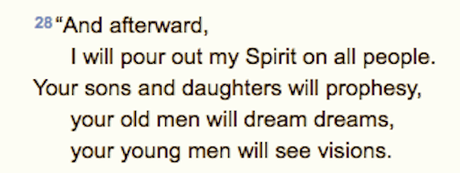
Joel 2:28, NIV Translation
In the Catalan journal El Critic, Irene Ramentol asks Benedictine Sister Teresa Forcades whether the idea of any kind of revolution in the Catholic church is just a dream (Rebel Girl has provided an English translation at Iglesia Descalza). Sister Teresa replies:
The spontaneous answer is "no". Moreover, it's necessary. In the case of the Church, the revolution should be anti-clerical and against the misogynist structure if we want a radical break with the structures that aren't serving the people. Clericalism has nothing to do with the Gospel or with the communities. It means that between God and the people there are mediators who are the clerics. In Matthew's gospel, when Christ died, it says that at that moment the veil of the temple, which marked the separation between sacred space and what isn't, was torn from top to bottom. That separation, not only in the texts but also in history, has brought social divisions. So what is more symbolic than that at the moment of Christ's death, it says that this division has ended? Here is something so radical that 21 centuries later, we still haven't understood it. And, on the other hand, the revolution must be against discrimination against women. Today in the Catholic Church, there's a link between the fact of being ordained as a priest and having access to decision-making positions within the Church. Because we women presumably can't be ordained, that means we can't have access to the places where decisions are made that affect us all.
As Christ died, the veil of the temple, marking the separation between sacred and secular space, was rent in two. And we Catholics have still not understood, after 21 centuries, that this means that the caste system of our church, with its separation of cleric from lay, is insupportable. And that the misogynistic discrimination against women built into the clerical system of domination of the people of God is, in the most fundamental way possible, antithetical to what Jesus stood for and died for . . . .
As I read Sister Teresa's illuminating theological analysis, how can I avoid thinking of Jerry Slevin's list of new year's resolutions for Pope Francis (and see here), with its appeal to his fellow Catholics to dream and dream large — about, among other things, ordaining women and permitting the laity to choose our bishops, as was the norm in the early church?

